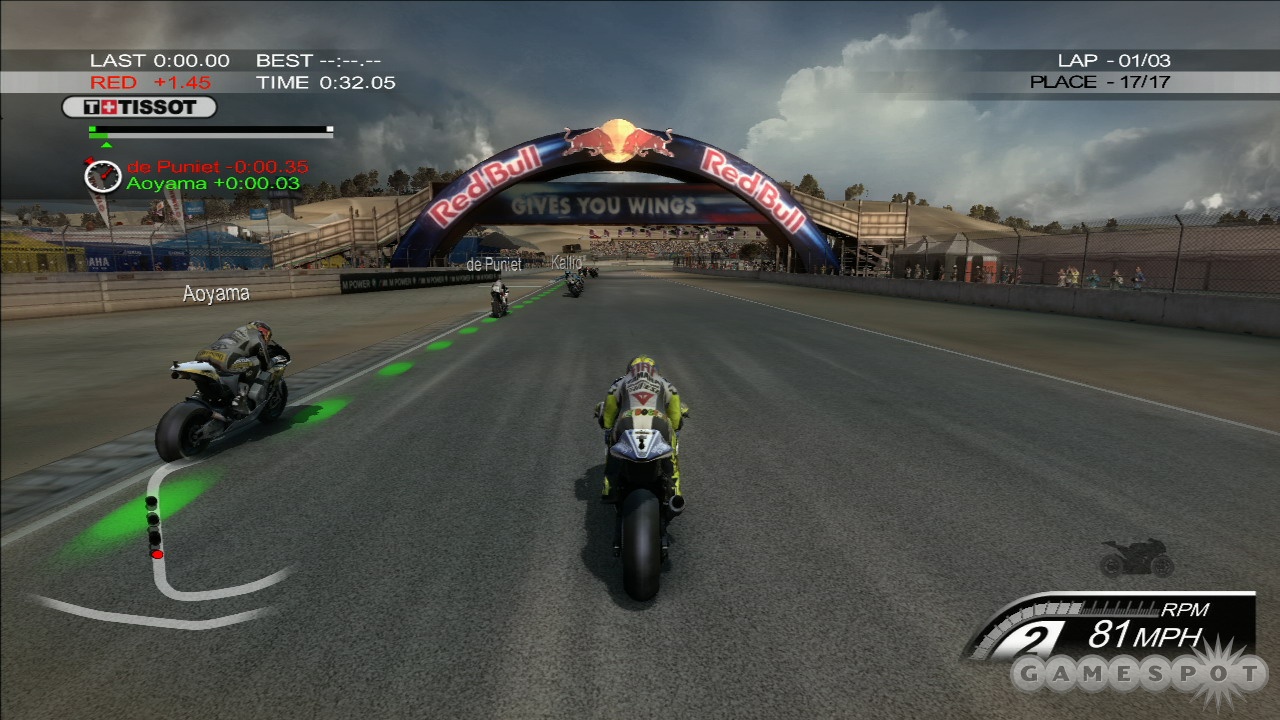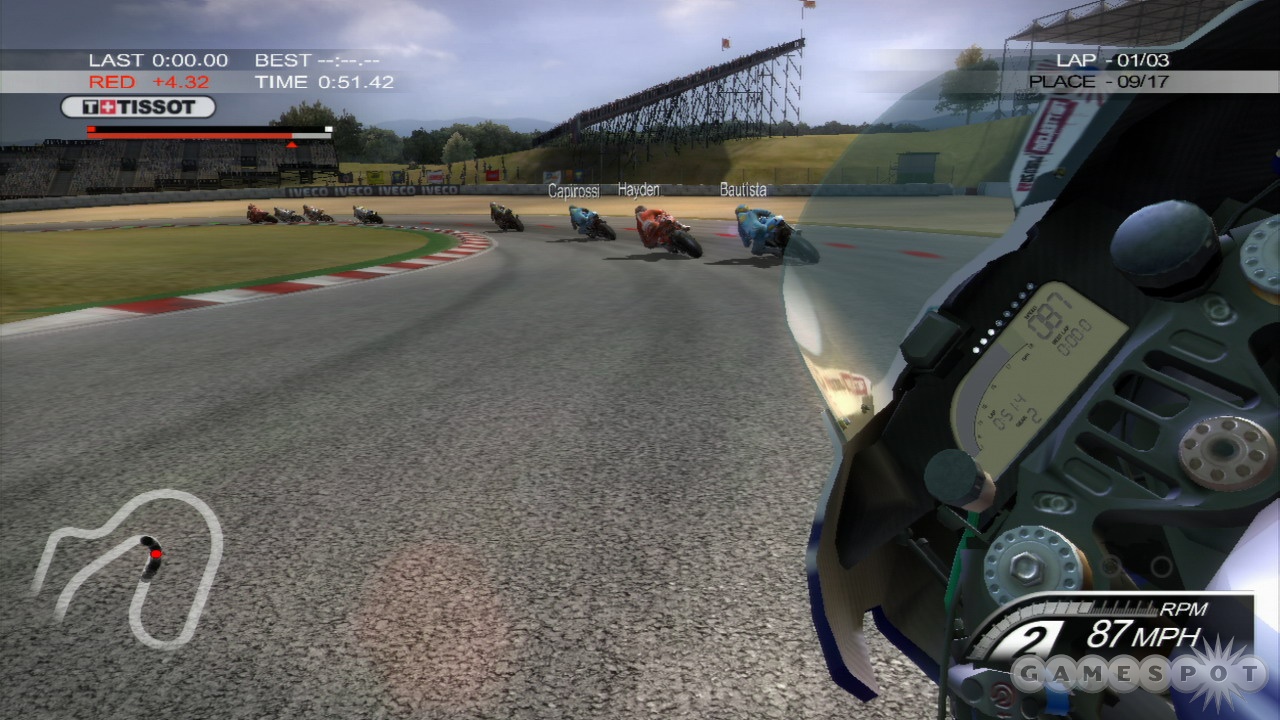In this latest official MotoGP game, you take on the role of a new rider in the lowly 125cc support class, hoping to work your way up to Moto2 and eventually the MotoGP series itself. The game includes all the riders, teams, and tracks from the 2010 season, with free downloadable content promised to update the game to the 2011 season once it begins. Before you take on Valentino Rossi and the rest of the 2010 MotoGP roster though, you must first get to grips with a handling model that certainly has simulation in mind. Unfortunately, as you work on building your team's reputation in Career mode, the game's numerous flaws, particularly in physics and graphics, begin to emerge. MotoGP 10/11 has great potential, but it's not fully realized in this iteration of the series.
On the track, this racer presents itself as a simulation. The initial assists selection screen is based on different levels of experience with racing games, from not playing them at all to familiarity with four wheels rather than two. However, the option of having all of the assists turned off is suggested only to those who have mastered motorcycle racing. By presenting the assists selection screen like this, the game does little to inform you about what the assists actually do. The option to turn these helpful aids on or off individually (such as traction control and automatic rider weight shifting) is buried under several option screens. MotoGP 10/11 presents itself as a simulation of the sport, but after only a handful of laps on the track, it becomes clear that it doesn't measure up.
The tuck-in button, which makes your rider crouch behind the windscreen for better aerodynamics on the straights, has an unrealistic effect on straight-line speed and allows you to breeze past riders during acceleration, despite the fact that they are tucking-in as well. However, for some reason, they overtake you very easily on long straights where they can often reach significantly higher top speeds than you. There are definitely signs of rubber-banding in the AI, which detracts from the game’s attempts at simulation. The biggest issue with the handling concerns weight shifting. On tight corners, particularly chicanes, it takes far too long for the rider to swap leaning from the left to the right, or vice versa. Compared to real MotoGP riders tackling chicanes and S-bends, those in the game seem overly lethargic. This fundamental lack of response from the bikes makes it very tough to become immersed in the racing and becomes very frustrating, particularly on harder difficulty levels where AI riders don’t have this issue.
There are some additional problems with the bike physics including an almost unchanged level of grip in wet weather and a complete lack of damage after crashes, both visually and mechanically. In wet conditions you would expect significantly longer braking distances, lower top speeds on straights and a need to reduce cornering speed, but in MotoGP 10/11 there is very little change. The lack of significant water spray from other riders in the wet also means that you also don't get the visibility problems you would expect in this adverse weather.
Along with the troublesome physics engine, the graphics in MotoGP 10/11 are lagging behind many other motorcycle games, as well as racing games in general. While the bikes are generally modelled well, the texture work is poor. The level of visual detail on the circuits is also inconsistent. Some tracks look great with a lot of trackside detail and realistic lighting patterns. However, the majority of normal daylight circuits suffer from flat lighting, and night races suffer from washed out lighting and poor draw distance. In the wet, there's very little spray from other bikes and the riders suffer from a lack of detail. In the normal chase camera, there are no animations for a rider's arms when adjusting the throttle or brakes and no animations on the rider's feet when changing gear. Hands are animated well in the game's surprisingly useable onboard camera, but the static feel of the riders in the other views doesn't endear any sense of immersion in the racing.

If you go into MotoGP 10/11 expecting a balanced simulation of the sport then you're going to be disappointed, but there's still some fun to be had in the career mode if you are willing to look beyond these problems. As in last year's game, you start a new 125cc team by choosing a name, a bike, and your team colours before heading out to the first race of the real season. Your ultimate goal is to move your team up into the Moto2 and MotoGP championships throughout an unlimited number of seasons. Slipstreaming, overtaking other riders, perfecting the racing line, and showboating during Career races all contribute to your grade score at the end of each event, which in turn adds to the reputation of your team. This allows you to hire new staff and find new sponsors. Unfortunately, the way the game calculates each of the in-race actions is unusual to say the least. You occasionally get showboating scores for missing corners entirely because bouncing over curbs and going airborne is seen by the game as a feat of motorcycle genius. The racing line that you need to perfect to earn extra reputation is also completely incorrect on some of the circuits, often forcing you to take ludicrously tight lines into slow 90-degree turns.
Happily, team management is implemented with far greater success. Hiring engineers allows you to research new upgrades for your bike. Each engineer has different specialties, such as engine or aerodynamics, so applying appropriate staff members to each research project means that they are completed faster. You can also apply multiple engineers to projects as another way to speed up the process. The other staff members you can hire include a PR manager, whose abilities determine which sponsors you can bring in and how good of a deal you get with them. Hiring multiple PR managers gives you access to bigger sponsors faster. You can choose where sponsor logos appear on your bike and leathers, as well as work to achieve sponsor objectives in races, which result in additional reputation and money. Sadly, the game uses imaginary sponsor companies rather than real-world organizations, so don't expect to be designing a sweet Red Bull team in MotoGP 10/11. Much of the team management content in Career mode, while very good, has hardly changed at all since last year's MotoGP 09/10, which introduced it.
Outside of Career mode, you can race in a world championship or single race with any team or rider from each of the classes included in the game. World Championship mode functions similarly to Career but with the management aspects removed so that you can simply focus on hitting the track to compete in practice/qualifying sessions and races with your favourite rider, rather than creating your own team. Sadly, the limitations of the handling model, even with every assist switched off, mean that the Championship mode is far less compelling than Career. On the other hand, should you crave the classic arcade motorcycle games of yesteryear, then Challenge mode is certainly the way to go. In this mode, a timer constantly counts down during races, but completing the reputation actions seen in Career mode adds time to the clock. If the clock runs down, then you must use a continue to carry on playing. This mode actually offers one of the most compelling trophies in the game--to complete a full season without using a single continue.
Online multiplayer is a limited affair in Moto GP 10/11 because it only supports single races with very few variables. You can race in each of the three bike classes, choose a race distance, and decide whether to have tire wear on or off. There is no persistence or stat tracking whatsoever, though you can race with up to 20 players, which is a remarkable achievement for a console racing game, albeit one that was also achieved in last year’s MotoGP title. You can even fill empty slots in your race with AI riders and choose their difficulty levels. More interesting than the online multiplayer, though, is the co-op option in Career mode, which allows a second player to join and play split-screen as your teammate. Its great fun and provides a real sense of teamwork which is missing from most racing games, despite the fact that every team in real racing has multiple riders. Sadly, there's no option to play Career co-op online, so you will need a like-minded biker friend to come over and sit down with another controller if you want to try out this mode.

MotoGP 10/11 is a game with some good ideas and the clear intention of simulating the feel of motorcycle racing at its highest level. It's a shame that various fundamental problems waste so much of its potential, particularly the major issue of slow weight shifting in the handling model. If the physics and graphics matched the precision of the team management systems in the Career mode, then this could have been a truly great motorcycle racing game for the current generation of consoles. Sadly, this will have to go down as a missed opportunity that has changed very little since last year's version, making Moto GP 10/11 a difficult game to recommend, even to fans of the real-life racing series.